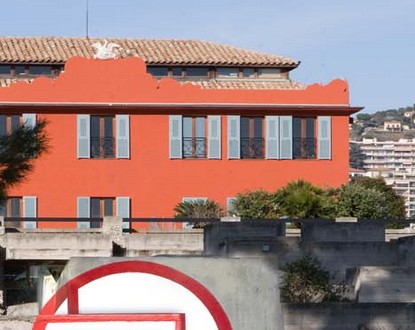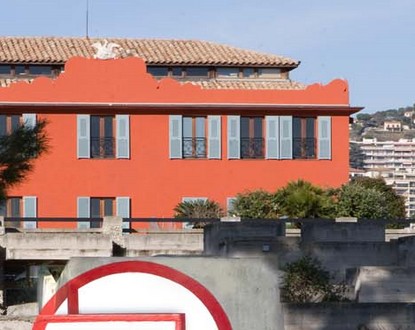The National Center for Contemporary Art at Villa Arson is presenting three exhibitions until October 30th, organized as part of the event “CONTEMPORARY ART AND THE CÔTE D’AZUR – A Territory for Experimentation 1951 – 2011.” An annual rendezvous, the National School of Art at Villa Arson is offering TWO PART exhibition, “DEMAIN C’EST LOIN,” featuring its 2011 graduates, at both Villa Arson and the Galerie de la Marine (in the city center).

A research on the history of performance on the Côte d’Azur from 1951 to today
This exhibition is conceived as the first stage of research conducted by the Villa Arson since September 2007 on the history of performance on the Côte d’Azur from 1951 to today.
This project will culminate in the summer of 2012 with the launch of the most comprehensive database possible on the subject, a publication, and a second exhibition bringing together films, photos, objects, and various documents.
Performance is characterized by the art of the gesture or action accomplished or organized in public (at least in the conditions of a confrontation or relationship with the public) by an artist at a given moment, in a unique timing (even if it can sometimes be repeated). It aims to destabilize aesthetic conventions, notably by breaking down genre barriers (visual arts, music, theater, dance, poetry, cinema…), while mixing scholarly and popular cultures. Performance also frees itself from traditional performance spaces by inventing new topographies of representation.
Performance is therefore the art of boundaries: the boundaries of the body, of course, but also of genres, forms, spaces, and thought.
The adventure begins in 1951 and 1952 with the presence of the Lettrists at the Cannes Festival, particularly with the 1952 screening of the film without images and without film “Drums of the First Judgment” by François Dufrêne, conceived as a genuine collective performance. The research then goes through the formal inventions of Yves Klein and Arman from the mid-1950s, followed by New Realism, Ben and his Total Theatre, and Fluxus, the presence of Georges Brecht and Robert Filliou at La Cédille qui Sourit between 1965 and 1968.
Beyond these founding fathers, art-action continues to renew itself to this day thanks to the creativity and energy of dozens of artists who invent new forms that traverse eras: Éric Andreatta, Marcel Alocco, Antoine Alvarez, Dominique Angel, Dan Azoulay, Éléonore Bak, Marcel Bataillard, Emmanuel Benichou, Daniel Biga, Frédérik Brandi, Anna Byskov, Julien Blaine, Jean-Michel Bossini, Caroline Bouissou, Robert Bozzi, Gilbert Caty, Hervé Courtain, Michel Cresp, Michel Crespin, Robin Decourcy, Niki de Saint Phalle, Erik Dietman, Noël Dolla, Joël Ducorroy, Éric Duyckaerts, Robert Erébo, Kristof
Everart, Daniel Farioli, Fred Forest, Yves Fournier, Jean-Baptiste Ganne, Olivier Garcin, Paul-Armand Gette, Doohwa Gianton, Claude Gilli, Jean-Pierre Giovannelli, Groupe Signe, Guignol’s band, Yoko Gunji, Cai Guo-Qiang, Raymond Hains, Raoul Hébréard, Max Horde, Michel Journiac, Judith Kele, Jean-Noël Laszlo, Pierre Le Pillouër, Jean-Jacques Lebel,
Virginie Le Touze, Jacques Lizène, George Maciunas, Denis Martinel, Jean Mas, Florent Mattei, Paul McCarthy, Médiastok, Bruno Mendonça, METCUC, Roland Miller, Elisabeth Morcellet, Patrick Moya, Georges Mucciarelli, Frédérique Nalbandian, ORLAN, Gina Pane,
Gilbert Pedinielli, Philippe Perrin, René Pietropaoli, Pierre Pinoncelli, Claude Rosticher, Mimmo Rotella, Ruy Blas, Sales Gosses, Serge III, Josée Sicard, Sophie Taam, Bernard Tréal, Nicolas Uriburu, Charly Van Rest, Bernar Venet, Jean-Luc Verna, Éric Watier, Junko
Yamasaki… (non-definitive list)
The exhibition transforms the square gallery of the art center into a place for presenting the research work.
The different information gathered in the database is projected through a graphic interface created by the g.u.i group, artist by artist, without yet revealing the original documents, according to four timelines distributed in the space like the cardinal points:
- 1951-1962: the emergence of personalities and foundational gestures,
- 1963-1972: the Fluxus wave that sows its poetic disorder,
-
1973-1990: the alternative spirit and committed attitudes,
-
1991-2011: the redefinition of genres and performance codes.
A nominative inventory (names of artists or involved individuals) and topographic (names of the places where performances took place) accompanies the projections.
Each
reference inscribed on the wall is doubled in a disparate manner, creating an almost vaporous reading of the whole.
A temporary working space is dedicated to collecting testimonies from the protagonists of this history.
Through this means, the information presented in the exhibition is updated in real-time during the eighteen weeks of the exhibition. The equipment for this office is provided by
Temporary meeting surfaces with two tables and a chair Modify by Charlotte Perriand, a black Elephant Stool by Sori Yanagi in 1954, and a white stool by Stacy
For an informed look at the exhibition, visitors are welcomed by students from the Villa Arson art school, true interlocutors regarding the stakes of the exhibition project, artworks, and artists’ approaches.
A documentation space assembles a selection of publications, audiovisual documents, and files dedicated to the project and exhibited artists.
Finally, the whole is accompanied by a soundtrack also produced by the g.u.i group, which suggests a research activity in progress through a palette of sound effects specially designed for the occasion. The sound is elliptical, similar to the way all the information in this exhibition is delivered.
The scenography is designed with a group of students from the superior school of visual arts of the city of Monaco (Pavillon Bosio), under the coordination of their teachers Mathilde Roman and Renaud Layrac.
The objective is to show ongoing research without fixing the information it contains, thereby creating the trailer for a future project.
Curator: Éric Mangion
Head of the research program: Cédric Moris Kelly, assisted by Christine Bavière
THE TIME FOR LISTENING
Sound and musical practices on the Côte d’Azur from the 1950s to today.
The exhibition “The Time for Listening” seeks to trace sixty years of sound and musical creation on the Côte d’Azur.
This history is built through the eyes of contemporary artists working or having worked in the region, who were asked to produce a work intended to resonate with past productions.
Concretely, this means that each artist takes charge of processing one or several sequences of this history by associating them with their own practice, creating original works that integrate past experiences.
The dialogues are as follows: Pascal Broccolichi & Lars Fredrikson, Vincent Epplay & Robert Malaval & The Rolling Stones, Jérome Joy & Jean Dupuy, Ludovic Lignon & Lars Fredrikson, Arnaud Maguet & Sun Ra, Arnaud Maguet & Soft Machine & Jean-Jacques Lebel, Arnaud Maguet & Richard Prompt, Isabelle Sordage & Éléonore Bak, Isabelle Sordage & Éliane Radigue, Gauthier Tassart & Thomas Köner, Gauthier Tassart & Jean-Pierre Massiéra, Christian Vialard & Yves Klein.
This choice is explained by the curators’ desire not to propose a historian’s exhibition, nor to limit the project to the presentation of archives, documents, or simply reactivated installations. It is perceived as the search for a singular writing to
analyze the particularly experimental field of sound and musical practices. It is also about relying on contemporary artists’ creativity to weave links between the past and their own experiences.
This position naturally raises the question of appropriation and its limits. How can a historical artist find their place in a contemporary work? Conversely, how can a current artwork assert its originality while being built on a past realization? How to make the uniqueness of meeting works readable?
By clearly asserting its postulate and the produced forms, appropriation becomes an aesthetic thought that goes beyond the mere play of citations and references. Thus, for this exhibition, it is no longer the chronological perspective that prevails in writing history, but the timeless relationship between different practices.
Generations and experiences no longer oppose each other. History becomes a continuous flow where it is not so much a matter of defining the role each artist played, as of the practices structuring it and the links they weave among themselves.
It is in this aim that the exhibition’s curators entrusted The Bells Angels (Simon Bernheim and Julien Sirjacq) to document the various adventures of this history. This involves compiling a cartography that reveals a set of linkages. Here, one discovers that sound and musical practices no longer oppose but instead constantly intersect. This documentary work integrates the exhibition, participating in its mediation but also in its scenography, creating focal points to enrich each of the installations.
Following their research, The Bells Angels are producing the exhibition’s publication. More than a catalogue, it aims to gather all the documents collected from the exhibited artists and various stakeholders or participants in this adventure. It will be the first time to write – at least in part – the history of sound and musical practices in this region while preserving the alternative and unique spirit that unites them.
Finally, The Bells Angels produce a sound piece from the exhibition for the Ateliers de Création Radiophonique at France Culture (broadcast scheduled for October 2011).
Curators: Jean-Marc Avrilla, independent curator, and Éric Mangion, director of the National Center for Contemporary Art at Villa Arson.
THE TIME OF TERRITORY
Contemporary architecture on the Côte d’Azur:
how to address architecture in an exhibition without necessarily staging the building’s photograph, its model, or plan?
This is the question answered by inviting Emmanuel Régent to give his perspective on a selection of contemporary buildings on the Côte d’Azur, accompanying the publication edited by the General Council of Alpes-Maritimes and Les presses du réel “Contemporary Architecture on the Côte d’Azur.”
The artist responds by creating a large mural fresco about fifteen meters long, composed of around twenty wooden supports, cut according to their master plan silhouettes, and arranged like a large-scale horizontal Tetris®. The whole forms a new cartography of the territory. The ensemble is elliptical, suggesting more than informing, primarily revealing an artist’s view on constructions that often escape our attention.
Among the architectural works mentioned, some will be accessible during guided tours, organized throughout the summer in the context of a circuit with the epicenter being Villa Arson.
This tour program will be led by Ève Roy, author and researcher in art and architecture history, who will carry out a residency at Villa Arson for the occasion. She will be occasionally accompanied by the architects themselves, designers of the sites.
The publication “Contemporary Architecture on the Côte d’Azur” documents, analyzes, and evaluates a significant part of architectural production from the past sixty-five years, from the expansion period to the renewal of the last decade.
It celebrates architecture as a creation and buildings as works (texts by Jean-Lucien Bonillo, architecture historian, and Jean-François Pousse, architecture critic).
This exhibition and Ève Roy’s residency that accompanies it are organized with the support of the General Council of Alpes-Maritimes.



